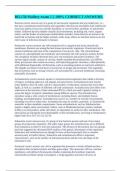BIL150 Mallery exam 2 || 100% CORRECT ANSWERS.
Bacteria correct answers any of a group of microscopic organisms that are prokaryotic, i.e.,
that lack a membrane-bound nucleus and organelles. Bacteria are unicellular (one-celled) and
may have spherical (coccus), rod-like (bacillus), or curved (vibrio, spirillum, or spirochete)
bodies. Different bacteria inhabit virtually all environments, including soil, water, organic
matter, and the bodies of eukaryotes (multicellular animals). Some bacteria are known to be
beneficial to humans and the higher animals, while many others are harmful; bacteria are the
chief cause of infectious diseases in humans.
Prokaryote correct answers any self-contained cell or organism that lacks internal unit
membranes. Bacteria are among the best-known procaryotic organisms. Procaryotes lack a
nuclear membrane and most of the components of eucaryotic cells. The cell membrane
consists of a phospholipid unit membrane and constitutes the cell's primary osmotic barrier.
The cytoplasm includes ribosomes that carry out translation and protein synthesis. The
nuclear region usually consists of circular, double-stranded deoxyribonucleic acid (DNA).
Many procaryotes also contain accessory, self-replicating genetic structures, called plasmids,
with additional dispensable cell functions, such as encoding proteins to inactivate antibiotics.
The flagella are distinct from those of eucaryotes in design and movement. The organelles
that are present, such as storage vesicles, are surrounded by a non-unit membrane consisting
principally of proteins.
Archaebacteria correct answers aquatic or terrestrial microorganisms that exhibit a diversity
of shapes, including spherical, rod-shaped, and spiral forms. Archaebacteria lack murein
(ester lipids) in the cell walls, which is characteristic of eubacteria; instead, they have ether
lipids, as well as a number of different cell-wall constituents. Archaebacteria also differ from
eubacteria in the structure of their ribosomal RNA's, which are used in genetic testing to
assess the degree of genetic relatedness among different species. The archaebacteria
reproduce using a wide variety of mechanisms, including binary and multiple fission,
budding, and fragmentation. Archaebacteria survive in a number of extreme environments,
including very hot or saline ones. Archaebacteria may be aerobic, anaerobic, or facultatively
anaerobic in their metabolic requirements. Some archaebacteria, such as Halobacterium,
require a highly saline environment. Others, such as Methanobacterium, produce methane
(CH4) as an end product, while still others are dependent on sulfur for their metabolism. The
latter group are among the most thermophilic of the archaebacteria, surviving in temperatures
higher than 45 to 50 C (113 to 122 F).
Eubacteria correct answers any of a group of true bacteria species and one of two major
groups of prokaryotic organisms. The other major group, the archaebacteria, are as different
from eubacteria as either is from the eukaryotes. The division of the bacteria into two groups
has been suggested by ribosomal RNA studies of the genetic information of the organisms.
Eubacteria and archaebacteria are thought to have evolved separately from a common
ancestor early in Earth's history. Eubacteria and archaebacteria differ in important
characteristics, such as the number of ribosomal proteins and the size and shape of the
ribosomal S unit.
Eucaryote correct answers any cell or organism that possesses a clearly defined nucleus, a
description that excludes bacteria and blue-green algae. The eucaryotic cell has a nuclear
membrane, well-defined chromosomes (bodies containing the hereditary material),
mitochondria (cellular energy exchangers), a Golgi apparatus (secretory device), an
, endoplasmic reticulum (a canal-like communication system within the cell), &lysosomes
(digestive apparatus within many cell types).
Virus correct answers an infectious agent of small size and simple composition that can
reproduce only in living cells of animals, plants, or bacteria. A virus consists of a single-or
double-stranded nucleic acid and at least one protein surrounded by a protein shell, called a
capsid. The nucleic acid carries the virus's genome--its collection of genes--and may consist
of either DNA or RNA. The protein capsid provides protection for the nucleic acid and may
contain enzymes that enable the virus to enter its appropriate host cell. Some viruses are rod-
shaped, others are icosahedral (a roughly spherical shape that is actually a 20-sided polygon),
and still others have complex shapes consisting of a multisided "head" and a cylindrical
"tail."
Cell division correct answers nucleus, chromosomes, centrioles, microtubules (spindle fibers)
microfilaments (cell furrow pinching it apart
Information storage & transfer correct answers nucleus, chromosome, DNA--> mRNA -->
ribosomes --> enzymes & proteins
Energy conversion correct answers mitochondria
Manufactures membranes & products correct answers ribosomes, rough E.R., smooth E.R.,
Golgi apparatus and its vesicles
Lipid synthesis & drug detoxification correct answers smooth E.R.
Digestion & recycling correct answers lysosomes and food vacuoles
Conversion of H2O2 to water correct answers peroxisomes
Structural integrity correct answers cytoskeleton: microtubules, microfilaments, intermediate
filaments
Movement correct answers cilia and flagella, microtubules, microfilaments (actin in muscles)
and pseudopodia
Exchanges with the environment correct answers plasma membrane and vesicles
Cell to cell connections correct answers tight junctions, desmosomes, gap junctions,
plasmodesma
Plant cell inter-cell communication correct answers plasmodesma
photosynthesis correct answers chloroplast
membrane cavity of metabolic waste correct answers vacuole
Microtubules correct answers Monomers and Structure:
hollow tube, helix of a and b tubulin dimers, forming a hollow tube 25-nm diameter




